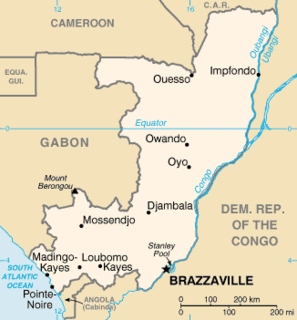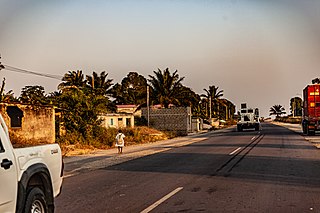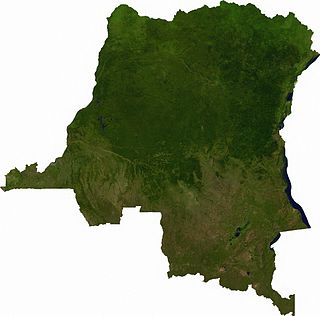Related Research Articles

The history of the Republic of the Congo has been marked by diverse civilisations: indigenous, French and post-independence.

The Kingdom of Ndongo, formerly known as Angola or Dongo, was an early-modern African state located in what is now Angola.

The Kingdom of Loango was a pre-colonial African state, during approximately the 16th to 19th centuries in what is now the western part of the Republic of the Congo, Southern Gabon and Cabinda. Situated to the north of the more powerful Kingdom of Kongo, at its height in the 17th century Loango influence extended from Cape St Catherine in the north to almost the mouth of the Congo River.

The Kingdom of Kongo was a kingdom located in central Africa in present-day northern Angola, the western portion of the Democratic Republic of the Congo, the Republic of the Congo as well as the southernmost part of Gabon. At its greatest extent it reached from the Atlantic Ocean in the west to the Kwango River in the east, and from the Congo River in the north to the Kwanza River in the south. The kingdom consisted of several core provinces ruled by the Manikongo, the Portuguese version of the Kongo title Mwene Kongo, meaning "lord or ruler of the Kongo kingdom", but its sphere of influence extended to neighbouring kingdoms, such as Ngoyo, Kakongo, Loango, Ndongo and Matamba, the latter two located in what is Angola today.

Soyo is a city, with a population of 200,920, and a municipality, with a population of 227,175, located in the province of Zaire in Angola, at the mouth of the Congo river. Soyo recently became the largest oil-producing region in the country, with an estimate of 1,200,000 barrels per day (190,000 m3/d).

Garcia II Nkanga a Lukeni a Nzenze a Ntumba, also known as Garcia Afonso for short, ruled the Kingdom of Kongo from 23 January 1641 to 1661. He is sometimes considered Kongo's greatest king for his religious piety and his near expulsion of the Portuguese from Angola.

The Kimpanzu were members of the Mpanzu kanda also known as the House of Kimpanzu, one of the lineages from which the kings of Kongo were chosen during the 17th century and following Kongo's reunification under Pedro IV. They are remembered in tradition and are evoked in a proverb, still current in the 1920s Nkutama a mvila za makanda "Kinlaza, Kimpanzu ye Kinlaza makukwa matatu malambila Kongo".
The Kinlaza were members of the Nlaza kanda or House of Kinlaza, one of the ruling houses of the Kingdom of Kongo during the 17th century. It was one of the main factions during the Kongo Civil War along with the Kimpanzu and Kinkanga a Mvika kandas. They are remembered in tradition and are evoked in a proverb, still current in the 1920s Nkutama a mvila za makanda "Kinlaza, Kimpanzu ye Kinlaza makukwa matatu malambila Kongo".

Articles related to the Democratic Republic of the Congo include:
Mvemba a Nzinga, Nzinga Mbemba or Funsu Nzinga Mvemba, also known as King Afonso I, was the sixth ruler of the Kingdom of Kongo from the Lukeni kanda dynasty and ruled in the first half of the 16th century. He reigned over the Kongo Empire from 1509 to late 1542 or 1543.
Lukeni lua Nimi was the founder of the Lukeni kanda dynasty, first king of Kongo and founder of the Kingdom of Kongo Dia Ntotila. The name Nimi a Lukeni appeared in later oral traditions and some modern historians, notably Jean Cuvelier, popularized it. He conquered the kingdom of Mwene.
Pedro III Nsimba Ntamba was a ruler of the Kingdom of Kongo during its tumultuous civil war period.
The precolonial history of Angola lasted until Portugal annexed the territory as a colony in 1655.
The Kongo Civil War (1665–1709) was an internal conflict between rival houses of the Kingdom of Kongo. The war waged throughout the middle of the 17th and 18th centuries pitting partisans of the House of Kinlaza against the House of Kimpanzu. Numerous other factions entered the fray claiming descent from one or both of the main parties such as the Água Rosada of Kibangu and the da Silva of Soyo. By the end of the war, Kongo's vaunted capital had been destroyed and many Bakongo were sold into the Trans-Atlantic Slave Trade.
Kanda in Kikongo is any social or analytical group, but often applied to lineages or groups of associated people who form a faction, band or other group. In Kongo documents written in Portuguese, or in older Portuguese accounts of Kongo it often is translated by "geração".

The Kinkanga, usually known as the Kinkanga a Mvika or House of Nsundi, was a royal kanda formed by King Pedro II, which ruled the Kingdom of Kongo from 1622 to 1631. While King Pedro II and his son Garcia I were the only other member of the faction or kanda to rule, it retained powerful members in provincial offices in the 1650s until its destruction in the 1670s. Despite this loss in prominence, they were remembered in tradition and are evoked in a proverb, still current in the 1920s Nkutama a mvila za makanda "Kinlaza, Kimpanzu ye Kinlaza makukwa matatu malambila Kongo".
Ambrósio I Nimi a Nkanga was a mwenekongo of the Kingdom of Kongo who ruled from
Henrique III Mpanzu a Nsindi a Nimi a Lukeni was ruler of the Kingdom of Kongo from the Kivuzi branch of the Kinlaza house, who reigned from 1840 until 1857. Henrique came to power when he overthrew his predecessor, André II. This was with the support of the elector Ntinu Nsaku. Henrique did not manage to kill Andre II and King Andre continued to exercise power from Mbanza Maputu over some of the Kongo realm.
Ana Afonso de Leão was a very important Kongolese princess and queen of Nkondo who conquered the territories of Lemba and Matari, as well as those located along the Mbidizi river in the Kingdom of Kongo in the 17th century in the regions of present-day Angola and the Democratic Republic of Congo. She was a decisive figure during the Kongolese civil war.
References
- ↑ Hilton, Anne: "The Kingdom of Kongo", page 38. Oxford University Press, 1985
- ↑ Foutou, Célestin Goma: "Histoire des civilisations du Congo", page 167. Anthropos, 1981
- ↑ van der Schueren, G.: "Onze kolonie en de kolonisatie", page 136. Standard-Boekhandel, 1946
- ↑ van der Schueren, G.: "Onze kolonie en de kolonisatie", page 136. Standard-Boekhandel, 1946
- ↑ van der Schueren, G.: "Onze kolonie en de kolonisatie", page 136. Standard-Boekhandel, 1946
- ↑ Foutou, Célestin Goma: "Histoire des civilisations du Congo", page 167. Anthropos, 1981
- ↑ Hilton, Anne: "The Kingdom of Kongo", page 38. Oxford University Press, 1985
- ↑ Foutou, Célestin Goma: "Histoire des civilisations du Congo", page 167. Anthropos, 1981
- ↑ French, Marilyn: "From Eve to Dawn, A History of Women in the World, Volume II", page 160. The Feminist Press at CUNY, 2008
- ↑ Hilton, Anne: "The Kingdom of Kongo", page 38. Oxford University Press, 1985
- ↑ Berger, Iris & E. Frances White: "Women in Sub-Saharan Africa: Restoring Women to History", page 78. Indiana University Press, 1999